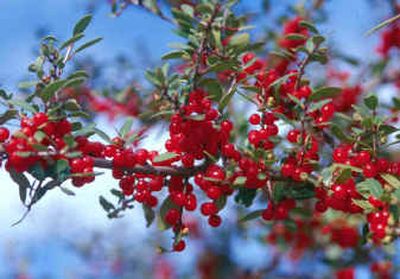Jollies of holly

NEWPORT NEWS, Va. — Holly is synonymous with the season to be jolly.
You see holly designs adorning wrapping paper and greeting cards. Holly sprigs embellish wreaths that welcome guests at your front door.
And who hasn’t belted out a few renditions of “deck the halls with boughs of holly.”
Holly, however, can provide year-round interest when you plant a few in your yard.
The red berries are bold and bright this time of the year. The spring flowers remind us warm weather is on the way. The leaves on the evergreen species stay with us, even through ice and snow.
There’s just plenty to like about holly.
“They do so well in our climate and fit in with most landscape styles,” says Les Parks at Smithfield Gardens in Suffolk, Va.
The holly genus botanically called Ilex features more than 400 species. Some are deciduous, losing their leaves in late fall to show off stems studded with clusters of red or yellow berries. Others are evergreen types with berries peeking around the sides of glossy green foliage. Some hollies produce black berries, some none at all.
Hollies also come in all sizes and shapes. Some are as small as 18 to 24 inches, while larger ones grow to be more than 50 feet tall. They grow in round, weeping and pyramidal shapes.
Their uses are as varied as their types. Smaller evergreen hollies make excellent low hedges or groupings in gardens, while taller evergreen hollies screen you from unwanted views and noise.
Best of all, many hollies provide refuge and food for some of our prettiest songbirds.
If you’re looking for a small evergreen holly, consider Ilex crenata, the Japanese variety that grows 3 to 10 feet tall and looks more like boxwood than holly. Helleri is one of the most-used types, a compact form that matures to 4 feet tall or less. Chesapeake holly is a favorite with Bruce Barton at the Flower Pot in Yorktown, Va.; it grows about 4 feet wide and 8 feet tall, making it ideal for small areas.
Another frequently used holly is Burford, or Ilex cornuta. A Chinese holly that produces berries without pollination, Burford comes in several sizes, including a dwarf version.
For a deciduous holly in your yard, check out Sparkleberry, or Ilex verticillata. In fall, yellow and orange leaves drop, leaving you with beautiful red berries to behold. Gardener Libbey Oliver likes Winterberry, a native type that tolerates wet soil. Both need a male such as Apollo for pollination.
“One year it snowed in February on the red berries, then the bluebirds came; what a picture,” she says about the Winterberry in her neighborhood garden.
Holly can also make a nice specimen or focal plant when it’s planted by itself rather than in a grouping. A popular one is Foster’s holly, which grows 7 to 10 feet wide and 20 feet tall; it also can be massed along property lines for privacy purposes. Another is lusterleaf holly, a slow-growing evergreen tree that reaches 30 feet tall with leaves that are 6 to 8 inches long. For smaller spots, try Mary Nell, which matures to 10 feet tall and produces ripe red fruit, says Tish Llaneza of Countryside Gardens in Hampton, Va.
Hollies also come with some interesting history attached to them. The Latin name for yaupon holly is Ilex vomitoria, named because Native Americans would brew black tea from it to induce vomiting.
“This was done as a purgative prior to rituals such as hunting or battle,” says Parks. “I’ve never tried this nor do I recommend it.”
All yaupons do well here, he adds, and are adaptable to varying light conditions and survive occasional droughts or wet soils. One of his favorites is a compact one called Bordeaux, which features burgundy new growth.
Another one he favors is the weeping yaupon, which reaches 15 feet tall or more and grows in an artsy manner. A heavy berry producer in this variety is Ocracoke, which was discovered on Ocracoke Island in North Carolina. This variety grows more like the wild species, but has a denser habit, darker green foliage and numerous berries, says Parks.